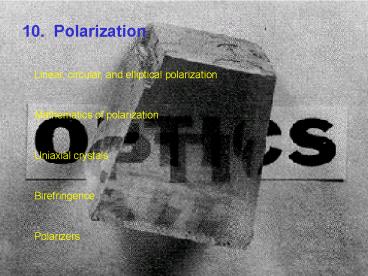10. Polarization - PowerPoint PPT Presentation
1 / 20
Title: 10. Polarization
1
10. Polarization
Linear, circular, and elliptical
polarization Mathematics of polarization Uniax
ial crystals Birefringence Polarizers
2
Polarization Notation
Parallel ("p") Perpendicular("s") polarization po
larization
Note the little lines and circles.
3
45 Polarization
Here, the complex amplitude, E0 is the same for
each component. So the components are always in
phase.
4
Arbitrary-Angle Linear Polarization
Here, the y-component is in phase with the
x-component, but has different magnitude.
5
The Mathematics of Polarization
Define the polarization state of a field as a 2D
vector "Jones vector containing the two
complex amplitudes For
many purposes, we only care about the relative
values (alternatively normalize this
vector to unity magnitude) Specifically
0 linear (x) polarization Ey/Ex 0
90 linear (y) polarization Ey/Ex
45 linear polarization Ey/Ex 1
Arbitrary linear polarization
6
Circular (or Helical) Polarization
Here, the complex amplitude of the y-component is
-i times the complex amplitude of the
x-component. So the components are always 90
out of phase.
The resulting E-field rotates counterclockwise
around the k-vector (looking along k).
7
Right vs. Left Circular (or Helical) Polarization
Here, the complex amplitude of the y-component is
i times the complex amplitude of the
x-component. So the components are always 90
out of phase, but in the other direction.
The resulting E-field rotates clockwise around
the k-vector (looking along k).
8
Unequal Arbitrary-Relative-Phase Components yield
"Elliptical Polarization"
The resulting E-field can rotate clockwise or
counter-clockwise around the k-vector (looking
along k).
9
The Mathematics of Circular andElliptical
Polarization
Circular polarization has an imaginary Jones
vector y-component Right circular
polarization Left circular polarization Elli
ptical polarization has both real and imaginary
components We can calculate the
eccentricity and tilt of the ellipse if we feel
like it.
10
Birefringence
The molecular "spring constant" can be different
for different directions.
11
Birefringence
The x- and y-polarizations can see different
refractive Index curves.
12
Uniaxial crystals have an optic axis
Uniaxial crystals have one refractive index for
light polarized along the optic axis (ne) and
another for light polarized in either of the two
directions perpendicular to it (no). Light
polarized along the optic axis is called the
extraordinary ray, and light polarized
perpendicular to it is called the ordinary ray.
These polarization directions are the crystal
principal axes.
Light with any other polarization must be broken
down into its ordinary and extraordinary
components, considered individually, and
recombined afterward.
13
Birefringence can separate the twopolarizations
into separate beams
Due to Snell's Law, light of different
polarizations will bend by different amounts at
an interface.
14
Calcite
Calcite is one of the most birefringent materials
known.
15
Birefringent Materials
16
Polarizers take advantage of birefringence,
Brewster's angle, and total internal reflection.
Combine two prisms of calcite, rotated so that
the ordinary polarization in the first prism is
extraordinary in the second (and vice
versa). The perpendicular polarization goes
from high index (no) to low (ne) and undergoes
total internal reflection, while the
parallel polarization is transmitted near
Brewster's angle.
17
Wollaston Polarizing Beam Splitter
The Wollaston polarizing beam splitter also uses
two rotated birefringent prisms, but relies only
on refraction.
The ordinary and extraordinary rays have
different refractive indices and so diverge.
18
The Nicol Polarizer uses two identical prismsof
calcite and TIR off a layer of optical cement.
Combine two prisms of calcite (with parallel
optical axes), glued together with Canada balsam
cement (n 1.55).
Snells Law separates the beams at the entrance.
The perpendicular polarization then goes from
high index (1.66) to low (1.55) and undergoes
total internal reflection, while the parallel
polarization is transmitted near Brewster's angle.
19
Glan-Foucault and Glan-Thompson polarizers
Two identically oriented prisms of calcite.
Ordinary ray undergoes TIR at the interface of
air (Glan-Foucault) or glue (Glan-Thompson).
Note that the perpendicular polarization is
transmitted (so some loss). Glan-Thompson has a
30 acceptance angle, but its glue
damages easily. Glan-Foucault is damage
resistant, but has only 10 acceptance.
20
Wire Grid Polarizer
The light can excite electrons to move along the
wires, which then emit light that cancels the
input light. This cannot happen perpen- dicular
to the wires. Such polarizers work best in the
IR. Polaroid sheet polarizers use the same idea,
but with long polymers.































